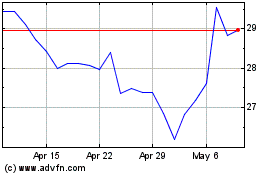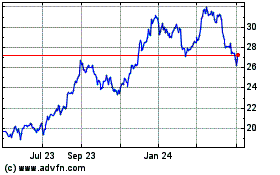U.K. Faces Long Tussle Over Split
June 24 2016 - 12:40AM
Dow Jones News
LONDON—The U.K. and the European Union now must navigate an
unprecedented separation while trying to prevent political and
economic turmoil.
British broadcasters forecast a vote to exit from the EU. The
result marks the beginning of the end for the U.K.'s 43-year
involvement in European political and economic integration.
The vote isn't legally binding, so Parliament now must pass laws
to make Britain's exit a reality.
The vote for Britain's exit, or Brexit, from the EU will unleash
a yearslong, highly bureaucratic tussle over how to actually
achieve that. There is no clear road map. The vote marks the first
departure from the modern-day EU, though Greenland in 1985 pulled
out of a forerunner of the bloc, the European Economic
Community.
In the U.K., the result is likely to have immediate
repercussions for Prime Minister David Cameron, who campaigned to
remain in the EU and who therefore suffered a bruising defeat.
Mr. Cameron is due to have his first post-referendum meeting
with other EU leaders next week in Brussels at a European Council
gathering scheduled for Tuesday and Wednesday.
Among Britain's next steps will be determining when to start the
process of severing its ties to Europe. Under Article 50 of the
EU's Lisbon Treaty, a member can give notice of its intention to
leave, opening a two-year window for negotiating terms of
withdrawal, meaning the U.K. technically remains a member until its
formal departure. The time period can also be extended.
The government hasn't spelled out exactly when it would seek to
start the clock ticking. Some senior officials, including Mr.
Cameron, have said they would enact Article 50 rapidly, however
some supporters of Britain's exit have said the U.K. wouldn't need
to rush.
One of the thorniest tasks will be to hammer out a trade deal
between the U.K. and the EU's remaining 27 members. It isn't clear
what access a post-EU U.K. would have to the bloc's vast single
market for goods and services, or what terms the EU would demand in
return.
Pro-Brexit campaigners offered differing views during the
campaign over what shape any new deal might take, citing EU
arrangements governing trade with Norway, Switzerland and Albania.
The terms of access to the EU's market could be critical for the
U.K.'s economic prospects.
Myriad other challenges face negotiators. Opposition to the free
movement of EU citizens was one of the driving forces of the
pro-Brexit camp. A British exit raises questions about the
immigration status of current and future EU workers in Britain, as
well as of the more than 1 million Britons living elsewhere in the
EU.
The vote to leave also raises questions about the future shape
of the U.K. itself. The debate underscored a divergence in public
opinion between English voters and their often more pro-EU
counterparts in Scotland, where nationalists harbor ambitions for a
rerun of the independence vote they lost in 2014. Nationalist
leaders in Scotland sent a strong signal before Thursday's vote
that they would push again for secession if Britain chose to leave
the EU.
The result is expected to trigger a slide in the pound and a
selloff in stocks, said Yianos Kontopoulos, a strategist at UBS
Group AG. Both had been gaining in the days ahead of the vote in
anticipation of a win for the pro-EU camp.
The world's major central banks, including the Federal Reserve,
the European Central Bank and the Bank of England, have signaled
their readiness to step in and calm any turmoil in financial
markets and, if necessary, make cash available in a variety of
currencies to any banks that face a funding squeeze.
BOE Gov. Mark Carney has said the central bank will need to
judge carefully whether to cut interest rates to support the U.K.
economy should growth falter, or to lift borrowing costs to
restrain inflation should the pound fall sharply.
Max Colchester contributed to this article.
Write to Jason Douglas at jason.douglas@wsj.com
(END) Dow Jones Newswires
June 24, 2016 00:25 ET (04:25 GMT)
Copyright (c) 2016 Dow Jones & Company, Inc.
UBS (NYSE:UBS)
Historical Stock Chart
From Mar 2024 to Apr 2024

UBS (NYSE:UBS)
Historical Stock Chart
From Apr 2023 to Apr 2024
